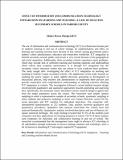| dc.description.abstract | The use of information and communication technology (ICT) in schools has become part of students learning in and out of school settings. Its implementation and effect on learning and teaching outcome have become of key interest among government policy makers: school administrators, educators and researchers worldwide. ICT integration in Nairobi secondary schools public and private is very crucial because of the geographical and social separation. Additionally, these secondary schools experience many problems, which may include lack of sufficient teaching and learning materials and understaffing which affects their academic performance. It is through ICT integration into the secondary school education system that can reduce or even eradicate these problems. The study sought after investigating the effect of ICT integration on learning and teaching in Nairobi County secondary schools. The significance of the study focused on enabling the policy makers to make rightful decisions pertaining to development of educational policies, help teachers and administrators to implement these policies and provide researchers with comprehensive understanding of edifying concerns affecting ICT integration in schools. The investigation followed a mixed method research design involving both quantitative and qualitative approaches towards generating and analyzing data. Specifically, the researcher used a descriptive survey research design to gather data from the target population across the county. The researcher used simple random sampling to select a representative sample of secondary schools, systematic sampling to select students and purposive sampling to select two County Directors, seven D.E.Os, seven principals and ICT teachers for individual interviews. The researcher self-administered questionnaires to 252 students. Data analysis involved qualitative and quantitative procedures. Qualitative data analysis transcribed into written texts and analyzed thematically. Quantitative analysis involved descriptive and use of Pearson chi-square statistical technique. The study findings revealed that 97.1% of the students used computers and their applications for learning purposes at school, 79.1% of these students used computers for individual and collaborative learning in and out of school. The researcher recommended that the management team ought to advance ICT schooling of all stakeholders through continuous in-service training, seminars and workshops, show a lot of interest in absorbing ICT and supply required ICT equipment. | en_US |

